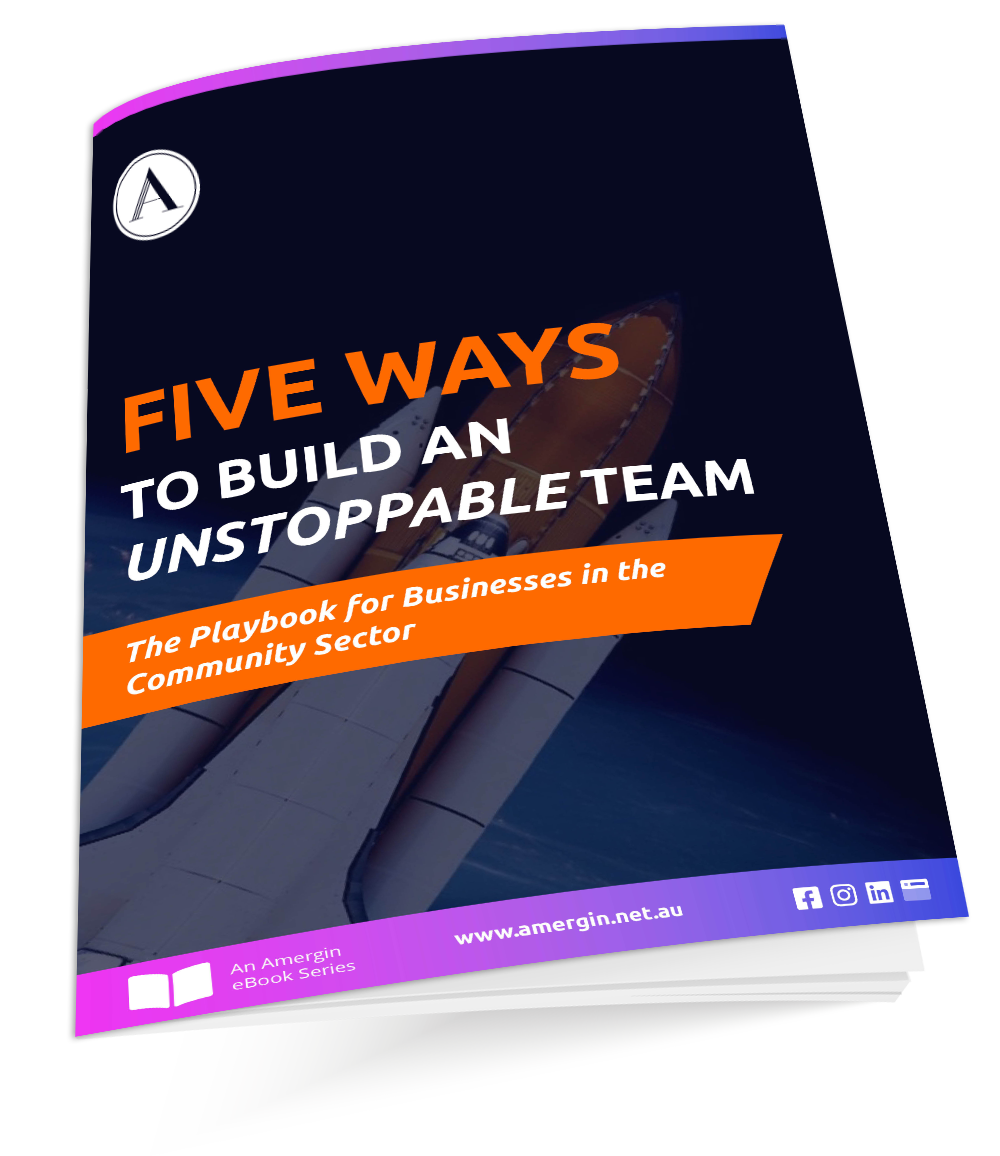The post Funding Available for Western Australian Businesses appeared first on Amergin.
]]>
Are you a small-to-medium (SME) business based in Western Australia? You might be entitled to government funding support of up to $20,000…
This funding forms part of the Industry Facilitation Scheme and is designed to enhance business capacity, capability and competitiveness to supply major projects and markets in Australia and overseas – this includes services within the NDIS and Aged Care markets.
The level of funding support under this round is 75% of eligible costs up to a maximum level of funding of $20,000 (excluding GST) per successful applicant – this means businesses must be prepared to front 25% of the total cost.
When do I need to apply by?
This round closes in January 2022.
If I am successful, how can Amergin help?
Our team are experts in compliance and can support you in the following ways:
Can Amergin help me complete the application itself?
Amergin is unable to help you complete the application form due to a conflict of interest between helping clients apply for the same grant.
Where can I find more information?
We encourage you to review the Guidelines as outlined in the National and International Standards Compliance Round.
The post Funding Available for Western Australian Businesses appeared first on Amergin.
]]>The post Residential Aged Care and the NDIS – It’s Time to Work Together appeared first on Amergin.
]]>
The Australian Institute of Health and Welfare (AIHW) identified in the People with Disability in Australia (2020) report that 5,600 people under the age of 64 are in permanent residential aged care.
Of the 5,600 young people living in residential aged care (RAC), 72% require high supports in relation to changed behaviours and 88% have limitations with their self-care.
As we know, the Australian Government is committed to minimising the need for younger people to live in RAC facilities. Until such a time however (2025 as per the Younger People in Residential Aged Care – Action Plan), the aim is for NDIS participants living in RAC to receive regulated care and support as per NDIS legislation.
Queue 1st December 2020 and surprise, any RAC provider supporting an NDIS participant within their facility automatically became registered NDIS providers. A process that usually takes in excess of 6 months (sometimes much longer) and involves extensive assessments, audits, documentation and education.
RAC providers automatically became responsible for managing participants, ensuring to support them to exercise choice and control over their lives, including their participation in the NDIS and how they receive care and services.
Now, as a result, many have spent the past 8 months wondering how they turn themselves into an NDIS provider as well as meet the growing requirements they already have within aged care.
Where it becomes increasingly confusing is, NDIS participants living in RAC are dual participants of the NDIS AND Aged Care systems. This means they can access RAC funds for their accommodation and care but also use their NDIS funds as well.
While this is a great outcome for the NDIS participant, especially given their need for high supports, it is evident from the work Amergin have been doing recently that unfortunately, the two sectors are NOT working together to ensure this happens.
The majority of RAC providers are not familiar with how NDIS funding works, NDIS portal claiming, NDIS plans, Support Coordination, and Plan Management. Not to mention the significant differences between NDIS participant goal setting and those of an aged care resident. In their defense, why would they be? They have spent countless hours making sure they understand their own sector, legislation, and Standards. Combining the two is a substantial undertaking.
There is also the added layer of confusion being experienced by NDIS providers who co-support NDIS participants living in RAC. Support Coordinators and Plan Managers are key stakeholders involved in supporting NDIS participants to live the life they chose and assist them with goal setting, activity planning and how best to spend their allocated NDIS funds.
And while Aged and Community Services Australia (ACSA) have partnered with the NDIS Commission to create the RAC NDIS Support Hub, resources are still in development given the infancy of the initiative itself.
NDIS Support Coordinators are attempting to understand the Aged Care legislation however as Disability Services Manager, Kelli Payne and her team from Marsden Families Program identified recently, “We have done quite a bit of research ourselves but there appears to be a huge grey area when interpreting and applying the [aged care] legislation” when it comes to funding and responsibilities.
It was not until Amergin spent time breaking down the differences across the sector including funding responsibilities that the Support Coordinators at Marsden Families Program could “move forward with confidence”, said Ms Payne and ensure their NDIS participants living in RAC could utilise their plans and funds for the better.
So how can you combine forces?
Our advice; start working together and educating each other.
Of course, utilise the supports from ACSA, however as they continue to develop it’s important to also provide support to each other. After all, each of you are experts in your area/sector. You have the ability to explain complex legislation to each other and transfer it into direct service provision understanding.
Before developing care plans or budgets for care and services, engage each other for education, support to navigate the claiming portal and stakeholder/case conferences to make sure you are all on the same page (RAC and NDIS providers).
Ensure you understand just how an NDIS participant’s funds work within RAC and the NDIS plan. Cross billing can be challenging to understand and navigate therefore lean on each other to fill any knowledge gaps along the way.
Lastly, engage the support of education and consultation firms (such as Amergin) who specialise in, and therefore understand, both the Aged Care AND NDIS sectors. That way you receive tailored advice and guidance in areas such as service provision, funding and claiming, policy and procedure revisions, and audit support.
We really are all in this together and the ultimate aim is to ensure participants/residents receive the care and services they need and are entitled to, with as little disruption to your efficiencies and business processes as possible. It can be done!
Next Steps
For more information on the topic of NDIS participants in Residential Aged Care and how best to receive support as a provider, book a consult with the team at Amergin.
The post Residential Aged Care and the NDIS – It’s Time to Work Together appeared first on Amergin.
]]>The post Inclusion, one piece of the Human Rights puzzle appeared first on Amergin.
]]>
What does inclusion look like in your in organisation?
Although the Olympics and Paralympics are soon to be filed away as not-so-distant memories of 2021, during the Games coverage two headlines caught my eye causing an internal conflict that I just can’t shake. One caused feelings of deep visceral outrage, where the other made me feel so proud. Both were about Paralympians, human rights, and the United States Olympic & Paralympic Committee (USOPC).
The first one read “Becca Meyers, six-time Paralympic medalist, withdraws 2021 Olympics after being denied medical accommodation”.
The second “US Paralympic athletes will receive equal pay for the first time at the Tokyo Olympics.”
One highlights how far we’ve come, where the other shows just how far we still have to go.
For context of the first article, in Becca’s words “the USOPC has denied a reasonable & essential accommodation for me, as a deaf-blind person to be able to compete in Tokyo, telling me repeatedly that I do not need a Personal Care Assistance (PCA) ‘who I trust’ because there will be a single PCA on staff that is available to assist me and 33 other Paralympic swimmers, 9 of whom are visually impaired.”
Within the Paralympian community some have shown their support for someone speaking up to address these human rights issues, where others like Roy Perkins have addressed these claims stating it is “not a human rights issue”.
Perkins goes on to say “This sounds horrible to the general public, who don’t realize that the majority of swimmers in every Games don’t have an assistant, despite often having disabilities which frankly are more severe than partial lack of sight and hearing…Full quadriplegic, fully blind, and intellectually impaired athletes have come without an assistant. Their teammates and the coaching staff helped them. They got through the Games safely and successfully. We build some character and learn to deal with doing sh*t we don’t necessarily want to do, living in non-ideal circumstances and leaning on each other while still performing at a high level.”
Let’s unpack this.
For anyone who has required personal care assistance or has provided this type of support to someone else, you know that the person is in a very vulnerable situation.
When reading Roy’s statement, on the surface it reads that the athletes are provided with support, though it raised the question was the support provided meeting the needs of the individual?
I believe you could argue no in both statements, it is just one person has decided to speak up where others before them have either tolerated the injustice or been ok with the support being provided by a stranger.
Simply, it is about choice.
It is a person’s right to choose who provides this very personal support, whether it is someone they trust or a stranger. It is about this choice being respected and listened to, to ensure their basic human rights are met. That is how it is a human rights issue.
When reading the second article I was humbled to read that in another instance, members of the Paralympian community’s basic human rights were met. For the first time US Paralympians efforts were being acknowledged equally at the beginning of the games, not an afterthought like in 2018.
It takes moments like this where we see a shift in the media, and what is ingrained into our subconscious mindset to showcase that people with disability are equally as talented as their able-bodied peers. This change starts will equal pay. This is a true reflection of inclusion, something we’re all striving for within the disability community.
Here in Australia, the National Disability Insurance Scheme (NDIS) is one of the systems in place working towards inclusion for people with disability to uphold their human rights. The NDIS is built on key community development principles to enhance and highlight the strengths at an individual and community level. As a Disability Provider, you may be asking yourself what does true inclusion look like for your organisation and the people you support, and what changes you can make to help piece together the human rights puzzle?
Follow these key themes to start your journey in promoting inclusion today:
Share skills and resources
This is about seeing the person for who they are, and what strengths and attributes they can offer. It is avoiding the traditional altruistic model which focuses on an able-bodied person having all the answers and skills. Instead, it means sharing the power, understanding that the only way to move forward is to listen and learn from one another. If you’re ever unsure, ask the experts, who in this instance are the people you support.
Identify community assets
Disability providers are just one piece of the human rights puzzle, it is important all staff, especially support staff are networking and exploring what different services and supports are in the community. These assets go further than government agencies, or other disability providers; it is the local community house, or the community garden down the road, or a peer support group, or a games club. The list is endless.
Create links and foster relationships
This is about forming relationships with the identified community assets and creating links between them and the people you support. It involves participation where a person is actively involved, rather than just attending. It is through these connections and relationships that true inclusion will be realised, and people with disability will have a wider choice on what is possible, and the opportunity to continuously learn from each other to shape a better more equal world.
Next Steps
Our team at Amergin are passionate about inclusion and supporting organisations to provide truly inclusive NDIS services to participants. To learn more, contact our Social Impact Consulting team today.
The post Inclusion, one piece of the Human Rights puzzle appeared first on Amergin.
]]>The post Mental Health First Aid and the NDIS – Does Your Workforce Have the Right Skills? appeared first on Amergin.
]]>
What impact can Mental Health First Aid have on NDIS providers, their staff and their participants?
Market analysis of NDIS growth trends continually identifies psychosocial disability supports as an area in need of significant development (and need for participant support).
With many providers stepping into this space, it’s important to be able to set yourself apart from the others and make your business a leading provider.
Speaking from experience, one of the biggest issues with finding the right provider ‘fit’ for psychosocial participants is the staff’s capability for supporting people who have challenging behaviours. This goes further than just the use of restrictive practices; more commonly the skillset needed is being able to understand and respond to unpredictable and fluctuating needs.
To do this well, staff need to be confident, capable, and adaptive. Time and time again it’s become apparent that these aren’t skills that come naturally to everyone, but thankfully they are skills that can be taught.
Being able to be a leading provider in this space means employing staff who have expert skills such as:
It’s not about having staff that knows absolutely everything, but it is about having staff that can do their specific job well. These skills come from experience, and they also come from knowing the best practice approaches and with staff feeling capable and confident each day when they come to work. In my experience, it’s when staff are scared or unsure that avoidable mistakes occur.
This is where professional development/training in Mental Health First Aid can fill that gap.
Mental Health First Aid (MHFA) teaches staff how to assist people who are developing a mental health problem, experiencing a worsening of an existing mental health problem, or in a mental health crisis, until appropriate professional help is received, or the crisis resolves.
MHFA training can be delivered in a tailored way that provides your staff with the necessary skill sets that will ensure they can support participants with psychosocial disability.
As a result, you and your staff will have:
About Kimberley
Having worked in the mental health and disability sector for over a decade, Kimberly has found a passion for educating and training workers to be able to better support those living with a psychosocial disability.
Throughout her career, she has coordinated services and supports for people who have complex needs due to their psychosocial disability. As a result, she has become adept at identifying providers who have a competent workforce and has learnt what to look for and what to avoid.
Kimberly has experience working with organisations to tailor evidence-based training to their staff to work either with specific participants or certain participant profiles, such as those who have challenging behaviours related to their Personality Disorders.
Kimberly is also a qualified Standard Mental Health First Aid instructor and has over half a decade’s experience delivering MHFA courses to NGOs, public health staff, and government agencies. Kimberly takes pride in being able to purposefully target content based on the trainees’ needs and area of work so it can be easily applied into their practice.
Current Offer
2-day community-based Mental Health First Aid courses from $150 per staff member, and private 2-day courses from $1000 per course*.
To register for a Mental Health First Aid course or to learn more about how you can provide the best service possible to your participants, Email Kimberly or phone her directly on 0405 560 937.
*Please note the fee structure differs for online course delivery.
The post Mental Health First Aid and the NDIS – Does Your Workforce Have the Right Skills? appeared first on Amergin.
]]>The post Risk Assessments: What you need to know appeared first on Amergin.
]]>
Risk assessments are a hot topic at the moment, particularly in the NDIS, as auditors focus in on how providers are managing their risks. And their findings indicate there is quite a lot of room for improvement!
So why are risk assessments so important? Because it’s the law? Because the Standards or Quality Indicators say so? We all know that is partly the reason but mostly it is because doing a thorough and detailed risk assessment allows you to see areas of your business that may be exposed or could cause harm to others. This provides you with an opportunity to consider ways to reduce possible impacts if those situations were to happen; which can save you thousands of dollars, plenty of time, and may even prevent you losing your entire business. Not to mention preventing a lot of pain and anguish from injuries or illness that could have been avoided.
Over the last few years, I have observed many providers taking the time to understand and work with their clients to assess possible risks for them (as well as their home environment and in community settings). This has included documenting the risks and periodically reviewing them with their staff members, the client, and other stakeholders actively involved. And rightly so – client safety is fundamental to delivering any type of supports. It has also been refreshing to see that completing client risk assessments is becoming ‘the way we do things’, as opposed to ‘don’t forget to do that risk assessment thing!’
But what about other risks? How are you managing risks to your staff? And what about your organisation? When auditors are looking at how providers are managing risks, they are looking at 3 key areas:
As a provider, you have a responsibility to identify, assess and manage all of the above risk types.
Risk Assessments should include identifying what the potential risks might be, the current controls you have in place to prevent or minimise those risks, and what other actions you can put in place to further reduce the possible outcomes. Any follow-up actions should be allocated to a responsible person in the organisation (who has the appropriate authority to do so), to ensure the action is completed.
Here are my top 4 tips for completing risk assessments:
- Include your staff members, clients (where possible) and other stakeholders when conducting risk assessments. Not only is this part of health and safety law (employers must consult with employees), but it helps to create engagement and ownership over risk management processes. Getting everyone on-board with safety allows a team approach, not leaving responsibility to only a few individuals.
- Have a consistent approach to assessing risks. By using a risk matrix that is applied across the organisation, it allows management to prioritise what needs to be done and how quickly based on how high (or low) the risk scores are. There are several methods you can use, although a common way is to follow the AS ISO 31000:2018 Standards and I would recommend this.
- Make risk assessments a part of your processes and the usual way you do things. Just as client risk assessments have become an expected part of intake procedures, make organisational and staff risk assessments standard procedure. This could be as simple as allocating time as part of staff meetings and management meetings to discuss and review risk assessments or any concerns that have been raised in relation to risk (and documenting the outcomes).
- Don’t forget to review risk assessments when things change. It’s easy to think your risk assessments are complete once they are done, but they should be living documents and updated when things happen.
Now what about Dignity of Risk?
Becoming a more focussed topic within the community sector, respecting a client’s right to take risks falls within your risk assessment processes too. It is important for organisations and staff delivering services to understand the concepts of dignity of risk… but I’ll save that for another article 😊
Next Steps
Understanding how to assess, mitigate and manage risks within your organisation can be a minefield.
This is where Amergin can help.
Our experienced and qualified team can provide education and support to help you better understand how to identify and manage the risks within your organisation.
Contact one of our Social Impact Consultants to find out more today!
The post Risk Assessments: What you need to know appeared first on Amergin.
]]>The post Approved Aged Care Provider | The Top 5 Things to Consider When Engaging A Consultant For Your Aged Care Application appeared first on Amergin.
]]>
You’ve made the exciting decision to apply to become an approved Aged Care provider, congratulations!
It’s through your initial research however you’ve identified the need for support. We get it, the application process can be overwhelming, daunting, and time-consuming and it is at this point you start to consider the use of a consultant to support you.
At Amergin we speak with hundreds of organisations each year who are seeking help with just that. Often however many feel in the dark and unsure about how to select the best consulting business for their needs.
To help you make your decision, we have developed the following Top 5 things to consider when engaging an aged care consultant on your journey to applying to become an approved aged care provider:
1. Review the experience of their business
With an increase in consulting businesses across Australia, it is easy to feel overwhelmed by the variety of options to choose from. We recommend however that you request to speak with a high-level staff member about the business’ experience supporting organisations through the application process specifically. A business can have many years of operations however if it has not specifically been with aged care application support, they are unlikely to know how best to provide you with expert advice and guidance. Consider asking them about the number of organisations they have assisted, for how long, and the full extent of their experience with the process. What learnings have they adapted to their continuous improvement activities and approaches?
2. Review the experience and knowledge of their people
In addition to the above, it is important that you are not only matched with a dedicated consultant to guide you through the process, but that their aged care team has extensive experience with the application process and knowledge of the sector firsthand. Just because a consultant has knowledge and experience of the NDIS registration process does not mean they understand the aged care application process given the two are starkly different. When it comes to knowledge of the sector, throughout the application process you will be studying and looking to understand the aged care legislation and Standards and how to implement those into practice. This is where you need to be able to lean on your consultant for advice and to help transfer what they know from directly working in a provider (at a high level, not as a Support Worker).
3. Question the numbers
Any experienced consultancy business involved in supporting organisations through the application process will know just how challenging it can be given ultimately it is up to the Commission whether someone is approved or not. This is why it is important that consulting businesses are transparent in relation to their client success rates and outcomes from the applicants they have supported. From the data released by the Australian Government in relation to new Home Care Package approved providers each quarter, it would be highly unlikely for a consulting business to claim a 100% success rate…
4. Don’t be afraid to ask for references
Not only will it assist you to make your decision, but it can also lead to a beneficial working relationship for you to align with an organisation that has just been through the application process. Don’t be afraid to ask the consultancy business before signing any paperwork that you’d like to speak with at least 2 previous organisations they have supported in the past 6-12 months. If the business has had successful outcomes and built lasting positive relationships with these providers, they will have no problem with sharing that information. When speaking with the references make sure to ask not only about their experience through the process in general but importantly any areas, they feel the consultancy business could have improved.
5. Lastly, remember you get what you DON’T pay for
In life if it’s too good to be true, it usually is. The same applies to consultancy businesses. When comparing considerably different prices, do they all compare in relation to services offered? Do the products and resources they supply match up? Will you receive one-on-one support from your own dedicated consultant or a team? Just how many hours of support can you expect? Will your documents be templates or tailored specifically to your business? Are you comparing apples to oranges?
The application process is challenging enough which is why we want to make sure in partnering for support, you find the right match for your organisation’s needs.
At Amergin we take pride in making sure we are transparent, supportive, and provide consulting services with an education focus given ultimately you are in the driver’s seat once it’s time to operate.
The support we provide organisations approaching the aged care application process have been adapted over time based on direct feedback from the Commission and the extensive experience of our team.


To learn more about how we can support you in your journey to becoming an approved aged care provider (and to compare our apples) feel free to get in touch with our aged care team.
Aynsley and Jennifer are looking forward to speaking with you soon.
The post Approved Aged Care Provider | The Top 5 Things to Consider When Engaging A Consultant For Your Aged Care Application appeared first on Amergin.
]]>The post Technology and the Generational Gap in the Workplace appeared first on Amergin.
]]>
Today’s workplace is a very different place to what it was when I began my working career 45 years ago.
Being born in 1960, I’m a member of the demographically large generation born between the end of WWII and mid-1960s, known as Baby Boomers. The term ‘boomer’ is derived from the boom in births that took place after the return of soldiers from WWII.
Employers today are now leading workplaces which are more generationally diverse than at any other time in history. Having four generations in the workplace is going to require a level of dialogue, understanding and interaction between people that probably hasn’t happened before. Generational diversity, although facing some challenges, has great potential and presents many opportunities for staff to share their knowledge and experience.
Addressing the positives and challenges of the age-diverse workforce begins with an understanding of the priorities and needs of each generation. From Baby Boomers to Gen Xs to Gen Ys (or Millennials) to Gen Zs, each group brings a different view on careers, technology and life in general. Here’s a look at the 4 generations comprising the work force today.
What Are The Generational Differences?
Today, there are roughly four generations employed in the workforce:
- The Baby Boomer Generation born between 1946-1964
- Generation X born between 1965-1980
- Generation Y or Millennials born between 1980-2000
- Generation Z born between 1995-2015
A Step Back In Time – My Experience With Technology in the 70s Workplace
I was employed as a Stenographer. For many of you unfamiliar with the term, a Stenographer transcribes speech in shorthand used especially for taking dictation. Shorthand is a phonetic system where the symbols do not represent letters, but sounds. These sounds are then represented by strokes which differ only in thickness, the thin stroke representing “light” sounds, the thick stroke representing “heavy” sounds. Vowels were also represented with dots and dashes. Doing this required a specialist fountain pen with a very fine, but flexible nib. Writing with shorthand symbols allowed you to write at a quicker speed than traditional handwriting so speed and accuracy were essential. Shorthand was used widely in the office as recording and dictation machines were yet to be invented.
After taking dictation, the next step was to decipher the strokes, dots and dashes and, using a manual typewriter, type the letter or document back into longhand. We were trained to ‘touch type’ which meant you weren’t to look at the keys as you typed so that your focus was completely on your shorthand notebook.
The process for using a typewriter went as follows – manually set your margins, place a piece of paper behind the cylinder and roll the paper up using a dial at the side until the paper is where you need to start typing. Align the paper, then push back the paper lock and the paper release lever and start typing. When you finish typing a line, the typewriter would activate a bell to let you know it was time to return the carriage manually to its original position with the carriage-return lever, and you would then continue typing on to the next line.
When the type began to fade it was time to change the ribbon spools. The ribbon is what transfers the ink to the paper when you strike a key. The ribbon was threaded through the carrier. Once the ribbon carrier was raised, we had to be sure it was threaded correctly and the new spool put back in the same way. Some typewriter ribbons have two different coloured pigments (usually black and red) which could be selected if the typewriter had a switch to allow for words or sentences to be written in a different colour when required. Today we click Bold or Italics, or both and have a wide selection of font sizes and colours to choose from.
Typically, a typewriter had an array of keys, and each one caused a different single character to be produced on the paper. If you made a mistake while typing, you had to start again – there were no delete buttons on a typewriter.
Today, we take for granted that modern technology allows us to print unlimited copies of documents from our computers, however photocopiers weren’t a luxury in most 70s offices, so carbon copies of typewritten documents had to be made instead. When placed between an original and a second piece of paper to be copied onto, carbon paper would transfer marks made by the pressure applied by a typewriter making a clean, legible copy of the original.
Typewriters continued their dominance in the 70s albeit with improvements. For example, electrical typewriters made an introduction to the workplace in the late 70s and were designed to minimize noise in the office environment. When there were many stenographers working in one office, in what was called a typing pool, the noise could be deafening when all were typing at once. A cartridge was also used to replace the ink rather than ribbon and spools so this was a big step forward.
A telex machine was a must in most workplaces. The telex is essentially a large typewriter with a punch-tape unit. It operated entirely in upper case and, prior to transmission, a tape would be prepared and checked. It could then be transmitted automatically once the number had been dialled and the connection made. Telex was a major method of sending written messages electronically between businesses. Its usage went into decline as the fax machine grew in popularity in the 1980s.
The telephone also looked very different than today’s office phone systems. Our offices and desks were outfitted with rotary dial phones. Like the mobile today, everybody had one, and they ruled domestic and office communications. All that changed in the 1980s when they were replaced by the push button telephone.
Office design, furniture and technology have changed substantially to reflect ever-shifting economic and cultural changes through the decades, setting the stage for some of the most advanced products today.
The Digital Age
The relationship between technology and Boomers is vastly different in comparison to the newer generations, particularly now the ‘digital age’ has emerged. We’ve gone from rotary phones and telex machines being the height of office innovation, to instant messaging, video conferencing and the quest for a good wi-fi connection so you can work from the cosy coffee shop nearby. The introduction of computers has diminished the need for huge filing systems, duplicate copies and off-site file storage.
A common misconception of Boomers is that they lack understanding of and/or fail to effectively utilise technology however, the expansion of radio, television, mobile phones, personal computers and the Internet have all been pioneered by Boomers.
Today Gen X and Millennials (children of the Baby Boomers) aren’t just the future leaders of industry – they’re already running the show as Managers. Gen Z, born after 1995, are also entering the workforce en masse. These three generations, all digital natives, are already shaping the workplaces of the future.
Millennials have grown up in a time of rapid change, giving them a set of priorities and expectations sharply different from the Baby Boomers. They have come of age during a time of technological change which has given them a different set of behaviours and experiences than their parents. By the year 2000, the entrance of social medial allowed customers to articulate their satisfaction with companies and make decisions based on the company’s behaviour and not just on price alone. So at this point, companies also began to react and change.
Current digital systems such as computers, smartphones, tablets and laptops have evolved over time. The availability of the Internet provides us with ready access to information anytime, anywhere. Connectivity enables us to conduct our shopping and banking online. We can stay in touch and communicate instantly with friends and family anywhere in the world via social media.
Building An Inclusive Culture In The Workplace
Today, both Baby Boomers and Millennials have access to the same technology. However, the behaviour towards technology and its usage differs between the two generations. The Boomers for instance, use the technology to assist them with getting the information they need and increasing their convenience. The technology in the hand of the Millennials is being used mostly for connections. The older generation sees the social networking and mobile technology as ‘new technology’, whereas for Millennials, it is just the where and how of interaction. Recognition and self-expressions are some of the goals the Millennials also want to achieve through technology.
Because of the fast growth in the technological evolution, the Boomers only had the opportunity to grow up seeing it, whereas the Millennials grew up knowing it.
Generations will come and go. Once it was a world with Baby Boomers, today it is the Millennials and soon, the world will be taken over by the next generation. Technology on the other hand will always stay and always evolve. It will always evolve in the hands of the current generation, who will pass it on to the next generation and by this, the technological evolution will keep on changing the generation’s behaviour and workplace culture.
Even though Millennials have studied and naturally learned to thrive in this digital age, the Boomers did well for themselves long before technology monopolized the workplace. They hold a lot of knowledge and insight into important things that future generations need to understand. Not to mention that people learn better when they feel respected, as they are more enthused to listen and become educated on unfamiliar topics.
Organisations are a diverse place. Employees of different generations have diverse management preferences not only because they view the world differently, but also because they are usually at very different career stages. The pivotal Millennial group prefers their manager to act like a coach or mentor, while Baby Boomers prefer a dependable and consistent manager. Beyond that, Millennials and Baby Boomers can complement each other well in a work setting, filling in the gaps to create a diverse and accomplished team.
Respecting and understanding each other’s views and values will allow different generations to increase their appreciation of one another. Mutual respect for one another – in the workplace and life in general – should always be first and foremost.
Leadership is the driving force of workplace culture. Management sets the behaviour standards through their words and actions, along with policies and procedures. A business must pay attention to the presence of stereotypes in its organization if it is to be successful and retain its most productive, knowledgeable employees. This in turn, will lead to better communication and collaboration because employees are now talking from a sense of appreciation and acknowledgement.
Understanding and aligning with the values of these multi-generational employees helps to achieve the organisation’s goals. By recognising these values and then building a workplace experience that lives up to them, businesses will not only attract and retain the best talent that transcends generations, but also achieve their goals sooner. At the same time they will gain a competitive advantage by building a culture that their entire workforce will thrive in.
Where do I start?
If you want to get started on building an inclusive team that are engaged and productive, you can download our Free eBook – Five Ways to Build An Unstoppable Team
Just click the link and enter your email address and we’ll send it to your inbox.
If your staff are disengaged or underperforming, you’re battling a tense work environment culture or you’re struggling with poor customer service, it’s a sign you may be dealing with an unhealthy team.
The post Technology and the Generational Gap in the Workplace appeared first on Amergin.
]]>The post Navigating the ECEI Labyrinth – What’s Ahead for ECEI Providers appeared first on Amergin.
]]>
What’s Ahead for ECEI Providers and Why it is Important for Families and Children
Grief, confusion, uncertainty, denial, frustration, worry, guilt, stress… just a few of the many emotions parents and families confront when their young child experiences developmental challenges or has a disability.
Trying to find the right support for a child can be like navigating a labyrinth. One key question of course is ‘What’s going on?”. The next is often ‘What do we do about it?”. The answer is commonly dictated by whether the child meets the diagnostic thresholds required to obtain government-funded support – an expensive exercise involving numerous visits to a variety of specialists.
Over the last 14 years we have seen increasing recognition of the challenges faced by parents and families in this situation, met with responses such as programs like Helping Children with Autism and Better Start for Children with Disability, through to a dedicated Early Childhood Early Intervention (ECEI) approach in the NDIS. However, there is still a way to go. 2019’s Tune Review put it well:
Further attention should be given to developing a model of planning for children that is more streamlined and provides more structured support for families early in their experience with the NDIS, in a way that prepares them for taking full control later in their NDIS journey. While the long-term aims of the NDIS are clear, more efforts need to be made to support parents and children on the journey from initial inexperience, stress, and disempowerment to being able to exercise informed choice and control.
On the back of numerous reviews and enquiries, including the Tune Review, and an Information Paper subsequently released by the Federal Government last year, the NDIA is now looking to make improvements to the NDIS’ ECEI approach, shaped around 23 recommendations (provided in full below this article). In amongst some big-ticket policy changes such as increasing the age limit for children supported under the approach to up to 9 years old, and having Early Childhood Partners conduct Independent Assessments to determine eligibility and budgets for children over 12 months of age, NDIS providers delivering Early Childhood Supports should take particular note of the following Recommendation:
Recommendation 6: Consider a range of mechanisms that will enhance compliance of providers with the NDIS Practice Standards on Early Childhood Supports and increase awareness by families of providers that adopt that best practice framework.
This recommendation is a response to three key issues1:
- industry concerns that many ECEI providers in the industry are not following best practice standards
- 80% of families and carers of young children are either self-managed or plan-managed, meaning they have the choice of using non-registered ECEI providers who do not have to demonstrate compliance with minimum standards like registered providers do, and
- families have limited knowledge of which ECEI providers are following ECEI best practice and how to find this out.
The recommendation essentially puts ECEI providers – unregistered and registered – on notice: a push for greater NDIS and ECEI best practice compliance – and better transparency around these – is coming.
Consultation currently underway is seeking feedback on how to make this a reality. Ideas put forward in the consultation papers2 include:
- providing better information to families about the benefits of using providers registered with the NDIS Commission
- establishing an industry-led ‘best practice accreditation system’
- establishing a quality feedback or rating system’
- making registration with the NDIS Commission mandatory for all ECEI providers, and
- requiring self and plan-managed participants accessing ECEI support to use only registered ECEI providers.
While the future hasn’t been written yet, it’s clear that whatever happens, ECEI providers need to be prepared to clearly demonstrate how they comply with both NDIS requirements, as well as ECEI best practice standards, regardless of whether they are formally registered with the NDIS Commission or not. And while this is only one policy response out of over 20, it is absolutely necessary, in order to provide stressed and anxious families with the clarity and assurance they need to make empowered choices for them and their child.
The good news is that the current consultation process is still open, giving providers an opportunity to contribute to and shape the approach they’ll need to work within. Submissions close on Tuesday 23 February 2021.
1Early Childhood Early Intervention (ECEI) Implementation Reset – Project Consultation Report, National Disability Insurance Agency (NDIA), November 2020
2Supporting young children and their families early, to reach their full potential, National Disability Insurance Agency (NDIA), November 2020
The post Navigating the ECEI Labyrinth – What’s Ahead for ECEI Providers appeared first on Amergin.
]]>The post The Royal Commission in to Aged Care – What’s Coming Next? appeared first on Amergin.
]]>
Alongside the Health Sector, 2020 has made the most significant impact on the Aged Care Sector across Australia; but it’s not over yet I’m afraid. In fact it’s only just getting started! Last month the Final Hearings (and subsequent Response to Counsel Assisting’s final submissions) came to a close for the Royal Commission in to Aged Care.
It was during the final hearing that Counsel Assisting reminded the Commissioners (the Honourable Tony Pagone QC and Ms Lynelle Briggs AO) that at the very first hearing in early 2019, the late Commissioner Tracey stated “The Royal Commission is a once in a lifetime opportunity to come together as a nation to consider how we can create a better system of care for elderly Australians that better aligns with the expectations of the Australian people”.
The purpose of the Royal Commission in to Aged Care (the RC) has been to confront a system that whilst for the most part tries the best it can with what little it has; however it’s still not good enough when vulnerable older Australian’s health, wellbeing and in some cases lives are in our hands. This falls upon the shoulders of the Australian Government but also Aged Care Providers equally.
Since commencing in January 2019, the RC has received 10,144 submissions and 6,729 telephone calls to the information line, conducted 25 hearings and workshops, 12 Community Forums, 2 Community Meetings, and visited 29 service providers.
Over this time a substantial amount of information has been shared highlighting the sector wide failings of a system that is long overdue for a shake-up.
Some of the RC’s initial recommendations involved requesting immediate Government action to:
- Provide more Home Care Packages to reduce the waiting lists for high level care;
- Address the over-reliance on chemical restraints predominantly in residential care; and
- Stop ANY person aged under 65 with disability from entering or remaining in aged care facilities.
While these 3 initial recommendations aren’t necessarily ‘quick wins’ for the RC (given there is still so much to work through), the Government did commence putting in place measures to work through the release of additional Home Care Package funding (albeit for lower level places not the high-level as recommended).
The Government also created a package of initiatives to help reduce the use of physical and chemical restrain in aged care homes. This will be supported by further updates to legislation and the development of educational messaging for pharmacists, nurses and personal care workers, approved providers of residential aged care services and families and decision makers.
Lastly the Government strengthened the Younger People in Residential Aged Care (YPIRAC) targets and ensure the 2020-2025 strategies would prioritise:
- Preventing younger people from entering residential aged care;
- Supporting younger people to leave residential aged care; and
- Supporting younger people while they are in residential aged care.
With the final report from the RC set to be released in February of next year (2021), it is clear this only just skims the surface of what needs to happen next.
In the October 2020 Final Hearing, Senior Counsel Assisting Peter Gray QC and Peter Rozen QC, presented submissions on behalf of the Counsel Assisting team over two days. They submitted 124 recommendations for consideration that focussed on the apparent poor care, lack of staff and support and how difficult it can be for older Australian’s to speak up/complain.
Given so many of our countries aged consumers currently accessing or needing care are considered part of the ‘silent generation‘, Commissioner Briggs and the late Commission Tracey made a point of reassuring the Australian public that they would “drive [their] policy agenda beyond change at the margin to transformative change, given the degree of substandard care that was apparent to [them]”.
As a result, the 124 recommendations tackle (to name a few):
- A whole new Aged Care Act by 2023
- The development of an Australian Aged Care Commission, Aged Care Advisory Council, Australian Aged Care Pricing Authority and hiring of an Inspector-General of Aged Care
- Improved public awareness of aged care
- Urgent review of the Aged Care Quality Standards
- Increase in Award wages, the development of a national personal care worker registration schedule (like the NDIS) and mandatory minimum qualification for personal care workers
- Improved complaints management processes and many more.
Greater weight is also to be attached to the consumer experience, something providers have struggled with for many years. While Consumer Directed Care is not a new concept for any provider, the recent findings from the National Ageing Research Institute (NARI) show that the majority of residential and home care consumers feel their needs are “mostly” not met and levels of satisfaction are low as a result. This is something that ALL providers need to start thinking about NOW including the investment they need to make back in engagement and collaboration with consumers. For those larger providers with thousands of consumers receiving support Australia wide – this is likely a message for you!
Lastly, the RC hasn’t forgotten about those new organisations wishing to jump through the hoops to become a new approved provider. You get a special mention too. One of the final recommendations is to create new approval requirements for all aged care providers, meaning the process is likely to become even harder than it already is – and rightfully so.
With consumers so vulnerable and silent in nature they can’t afford for anyone to get this wrong, especially the Commission making the decision.
Steps Providers can take as a result of the Royal Commission in to Aged Care
While we will monitor the recommendations and what is presented formally, and subsequently accepted by the Government come February 2021; I would recommend that providers read through the initial 124 recommendations and start planning sooner than later. Focus on areas that are likely to be accepted by the Govt and those that will directly impact how you provide services.
Don’t wait for the next steps, plan for them now! Need Help? Schedule a Consult today.
The post The Royal Commission in to Aged Care – What’s Coming Next? appeared first on Amergin.
]]>The post WA NDIS Transition to National Framework Begins appeared first on Amergin.
]]>
The WA NDIS Transition has begun! From 1 December 2020, Registered NDIS Providers operating in Western Australia (WA) were able to start renewing their registrations with The NDIS Quality and Safeguards Commission (The NDIS Commission).
This is not only significant for NDIS Providers who are now required to comply with the National NDIS Practice Standards, but also for the NDIS Commission who now oversees ALL providers across all States and Territories.
The transition was delayed due to the COVID-19 epidemic. Earlier this year, WA providers requested that the transition be deferred to allow them to focus on critical support issues for people with disability during the initial phase of COVID-19 and a subsequent recovery period.
Here’s Our Top 5 Things Providers Need To Know About the WA NDIS Transition
1. What are the main changes I should be aware of?
The NDIS Quality and Safeguarding Framework presents several key differences that providers need to be aware of. These include a new NDIS Code of Conduct and NDIS Practice Standards, which set out expectations for the quality and safety of the services and supports providers deliver.
There have also been changes to provider registration and the way complaints are made, incidents are reported, behaviour support plans are developed and checked, and worker screening is undertaken. Unregistered providers are also subject to new requirements including the NDIS Code of Conduct and complaints handling arrangements.
You will also need to know whether you’ll need to go through Verification or Certification process – our VeriCert Pilot will help you do this easily.
2. How do I start renewing my registration?
You should have received a letter from the NDIS Commission inviting you to renew your registration through their online portal.
Our tips before you start the renewal:
- Familiarise yourself with the NDIS Practice Standards.
- Update your organisation’s policies and procedures as soon as possible so they meet the new National Practice Standards.
- Make sure you don’t start your self-assessment until you’re ready – once you’ve started, you only have 60 days to complete it.
3. Will I need to do an audit straight away?
No, you won’t need to do an audit immediately. You will be generally be given timeframe that you must start the renewal process. From there, you will be given further time to book and complete your audit.
4. Where can I get more information?
You can find more information and resources, including the NDIS Practice Standards and NDIS Code of Conduct, on the NDIS Commission website. You can also contact the NDIS Commission at 1800 035 544.
5. How Can Amergin help me renew my registration?
Our team are experts in NDIS registration and renewal and below are two ways we can help.
| Show me how to do it myself | I’m Too Busy – Please Help! |
|---|---|
|
If you have some time on your hands, we’ve put everything in one place (on amerginhub) to help you renew yourself.
|
We get it, you’re busy being the best provider you can be. We can do the heavy lifting for your and whilst guiding you through the entire renewal process plus provide a range of other business services.
|
The post WA NDIS Transition to National Framework Begins appeared first on Amergin.
]]>